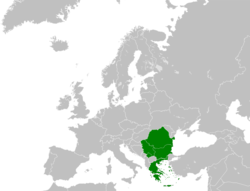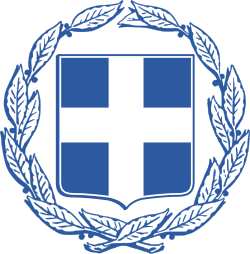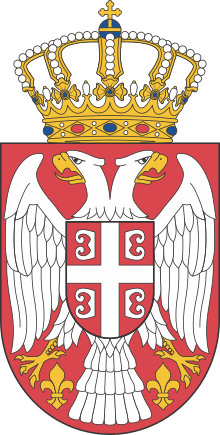Craiova Group
The Craiova Group (Quadrilateral), Craiova Four, or C4 is a cooperation project of four European states – Romania, Bulgaria, Greece and Serbia – for the purposes of furthering their European integration as well as economic, transport and energy cooperation with one another. The Group originated in a summit meeting of the heads of governments of Bulgaria, Romania and Serbia, held on 24 April 2015 in the Romanian city of Craiova.[3][4] At the group's inaugural meeting, Romania's then-Prime Minister Victor Ponta indicated that he was inspired by the Visegrád Group.[3] Romania and Bulgaria both joined the European Union on 1 January 2007, while Serbia has been in accession negotiations since January 2014. Since October 2017 at the meeting in Varna, Bulgaria, with the inclusion of Greece, meetings have been quadrilateral.[5][6][7][8][9][10][11]
Craiova Group Quadrilateral | |
|---|---|
 Map of Europe indicating the member countries of the Craiova Group | |
| Membership | |
| Establishment | 24 April 2015 |
| Area | |
• Total | 569,594 km2 (219,921 sq mi) |
| Population | |
• 2019 estimate | |
• Density | 78.9/km2 (204.4/sq mi) |
| GDP (PPP) | 2018 estimate |
• Total | |
• Per capita | |
| GDP (nominal) | 2018 estimate |
• Total | |
• Per capita | |
One of the first initiatives, after a meeting in Vidin, Bulgaria, was to strengthen the telecommunication networks in the border areas of the countries.[12] Other goals include helping Serbia join the European Union and the construction of a motorway linking Bucharest, Sofia and Belgrade.On 19th of May 2020 All four countries agree to open borders on 1 June 2020,because of stable situations in those countries.[3]
On 2 November 2018, Prime Minister of Bulgaria Boyko Borisov stated that Prime Minister of Greece Alexis Tsipras proposed joint bid for the 2030 FIFA World Cup by Bulgaria, Romania, Serbia and Greece during the meeting in Thessaloniki.[13]
Country comparison
| Name | Romania | Bulgaria | Greece | Serbia | ||||
|---|---|---|---|---|---|---|---|---|
| Official name | Romania (România) | Republic of Bulgaria (Република България) | Hellenic Republic (Ελληνική Δημοκρατία) | Republic of Serbia (Република Србија / Republika Srbija) | ||||
| Coat of Arms |  |
 |
 | |||||
| Flag | ||||||||
| Population | ||||||||
| Area | 238,397 km2 (92,046 sq mi) | 110,993.6 km2 (42,854.9 sq mi) | 131,957 km2 (50,949 sq mi) | 88,361 km2(34,116 sq mi) | ||||
| Population Density | 84.4/km2 (218.6/sq mi) | 64/km2 (165.8/sq mi) | 82/km2 (212.4/sq mi) | 91.1/km2 (235.9/sq mi) | ||||
| Government | Unitary Semi-presidential constitutional republic | Unitary parliamentary constitutional republic | Unitary parliamentary constitutional republic | Unitary parliamentary constitutional republic | ||||
| Capital | Bucharest – 2,106,144 (2,412,530 Metro) | Sofia – 1,238,438 (1,681,592 Metro) | Athens – 664,046 (3,781,274 Metro) | Belgrade – 1,166,763 (1,687,132 Metro) | ||||
| Largest City | ||||||||
| Official language | Romanian | Bulgarian | Greek | Serbian | ||||
| First Leader | Alexandru Ioan Cuza, Domnitor of the United Principalities (first ruler of the modern unified state) | Khan Asparuh of Bulgaria (founder of the First Bulgarian Empire) | Governor Ioannis Kapodistrias (first head of state of the modern independent state) | Prince Višeslav of Serbia (first ruler known by name) | ||||
| Current Head of Government | Prime Minister Ludovic Orban (National Liberal Party (Romania)) | Prime Minister Boyko Borisov (GERB) | Prime Minister Kyriakos Mitsotakis (New Democracy) | Prime Minister Ana Brnabić (SNS) | ||||
| Current Head of State | President Klaus Iohannis (Independent) | President Rumen Radev (Independent) | President Prokopis Pavlopoulos (New Democracy) | President Aleksandar Vučić (SNS) | ||||
| Main religions | 81% Eastern Orthodox, 6.2% Protestant, 5.1% Latin and Greek Catholic, 0.2% irreligious, 1.5% Other religious | 59.5% Eastern Orthodox, 9.3% irreligious, 7.9% Islam, 0.9% Protestant, 0.7% Roman Catholic | 90% Eastern Orthodox, 3% Other Christians (excluding Catholic), 4% irreligious, 2% Islam, 3% Other religious (including Eastern or Western Catholic) | 84.59% Eastern Orthodox, 4.97% Roman Catholic, 3.1% Islam, 1.11% irreligious, 0.99% Protestant, 3.54% Other religious | ||||
| Ethnic groups | 88.9% Romanians, 6.1% Hungarians, 3.3% Roma, 0.2% Ukrainians, 0.2% Germans | 84.8% Bulgarians, 8.8% Turks, 4.9% Roma, 0.7% others | - | 83.3% Serbs, 3.5% Hungarians, 2.1% Roma, 2% Bosniaks, 9% others | ||||
| GDP (nominal) | ||||||||
| GDP (PPP) | ||||||||
| External debt | 36.8 % of GDP | 22.3 % of GDP | 178.2 % of GDP | 48.2 % of GDP | ||||
| Currency | Leu (L) – RON | Lev (лв) – BGN | Euro (€) – EUR | Serbian dinar (din) – RSD | ||||
| Human Development Index |
See also
References
- "Population on 1 January". ec.europa.eu/eurostat. Eurostat. Retrieved 13 September 2019.
- "World Economic Outlook Database, April 2019". IMF.org. International Monetary Fund. Retrieved 13 September 2019.
- "Bulgaria, Romania, Serbia Establish Craiova Group for Cooperation". Novinite. 24 April 2015.
- "Vucic meets with Romanian and Bulgarian counterparts". B92. 24 April 2015.
- "Prime Minister Mihai Tudose participated in the Romania - Bulgaria - Serbia - Greece quadrilateral meeting". gov.ro. 9 December 2017.
- https://www.opendemocracy.net/democraciaabierta/rodrigo-vaz/what-does-future-hold-for-southern-europe
- http://rbj.ucoz.ro/news/craiova_group_a_quadriatral_cooperation_formula_more_important_than_the_visegrad_group/2018-04-24-277
- http://www.balkaneu.com/joint-military-exercise-of-greece-bulgaria-romania-serbia-in-attica/
- https://sofiaglobe.com/2018/04/24/leaders-of-bulgaria-greece-romania-serbia-meet-in-bucharest-on-april-24/
- http://int.ert.gr/pm-tsipras-in-bucharest-for-greece-bulgaria-romania-serbia-meeting/
- http://www.xinhuanet.com/english/2018-04/25/c_137134385_2.htm
- "България, Румъния и Сърбия свързват телекомуникационните си мрежи" (in Bulgarian). Investor. 17 June 2015.
- "Bulgaria, Romania, Serbia, Greece eye joint bid for hosting 2030 FIFA World Cup". seenews.com. Retrieved 2 November 2018.
- "Population on 1 January". ec.europa.eu/eurostat. Eurostat. Retrieved 2 April 2020.
- "Human Development Index (HDI)". hdr.undp.org. HDRO (Human Development Report Office) United Nations Development Programme. Retrieved 11 December 2019.
- "Inequality-adjusted Human Development Index (IHDI)". hdr.undp.org. HDRO (Human Development Report Office) United Nations Development Programme. Retrieved 11 December 2019.

